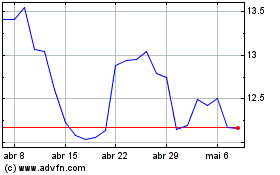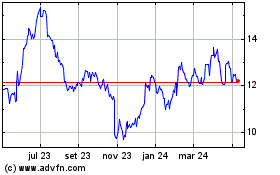By Mike Colias
Ford Motor Co.'s Chief Operating Officer Jim Farley will take
over as chief executive, succeeding the retiring Jim Hackett, who
is more than three years into a turnaround effort that has yet to
lift profits or the auto maker's depressed share price.
The company said Tuesday Mr. Farley, 58 years old, will succeed
Mr. Hackett, 65, on Oct. 1. Mr. Hackett will remain in an advisory
role through next spring, the company said.
Ford was already struggling to revamp its money-losing overseas
operations when the coronavirus pandemic forced auto makers to shut
down their factories, sending Ford scrambling to borrow money as it
burned through billions of dollars in cash. Ford's factories have
recovered nearly to prepandemic levels and the company last week
signaled a third-quarter profit.
Mr. Farley emerged in February as the leading contender to take
over, when the former strategy chief and longtime marketing
executive was elevated into the chief operating officer role. His
promotion coincided with the sudden retirement of Ford's president
of automotive, Joe Hinrichs, who essentially had been serving as a
co-No. 2 with Mr. Farley in what many viewed as a competition for
the top job.
Ford Executive Chairman Bill Ford Jr. said the CEO change has
been planned for some time. He lauded Mr. Hackett for revamping
Ford's vehicle lineup, in part by shedding unprofitable sedans, and
taking on a major revamp of Ford's business outside the U.S.
through a continuing, multibillion-dollar restructuring.
"It's my belief that he still doesn't get enough for taking on
the tough issues," Mr. Ford said during a media conference call
Tuesday. He also described Mr. Farley as a "car guy" who
understands the technological shifts disrupting the car business,
from driverless cars to the influx of digital services into the
cockpit.
Ford's stock was up 1.8% in midmorning trading, to $6.82.
Mr. Hackett, a former office-furniture CEO who had no
auto-industry experience before arriving at Ford, was appointed CEO
in May 2017. At the time, Mr. Ford praised him as a change agent
who could guide the company's long-range strategy in an industry
buffeted by disruption, from big bets on electric and driverless
cars to incursions by tech giants looking to take more control of
the car's cockpit.
But beyond mapping the future, Mr. Hackett has grappled with
more-pressing problems in Ford's manufacturing business today that
continue to weigh on profits.
Troubles have popped up in Ford's U.S. business, its main profit
generator. The company stumbled last year on the first redesigned
Explorer SUV in nearly a decade, one of the auto maker's most
important vehicle launches in years. Quality problems on certain
models also have led to higher warranty costs, which swelled to
around $5 billion, roughly 30% higher than past years, Mr. Farley
told analysts in February.
Ford's operating profit has fallen for three straight years,
including a 9% drop in 2019, to $6.38 billion, a year in which
executives at one point thought they would increase earnings. Mr.
Hackett said in February that he was disappointed in the 2019
results, after having signaled that was the year Ford would reverse
the earnings slide.
The Dearborn, Mich., auto maker's results have contrast with
rival General Motors Co., which has posted better profit margins
and shown greater earnings resilience during the pandemic. In the
second-quarter, GM breezed past analysts' expectations, reporting a
$589 million operating profit for the April-to-June period, while
Ford posted an operating loss of $1.9 billion.
Investors have punished Ford in the wake of the disappointing
results. Shares had been hovering around a decade-low before the
pandemic sent them down further, though they have rallied about 67%
since the spring, to $6.69 at Monday's close. They have fallen 40%
during Mr. Hackett's tenure.
To combat losses overseas, Ford is in the early stages of a
multiyear, $11 billion restructuring that includes closing plants
and shedding workers in Europe and Latin America. Mr. Hackett has
shuffled his executive team in China, where Ford's sales have
cratered more than 60% from their peak a few years ago,
transforming years of steady profit into losses.
Mr. Hackett, a former University of Michigan football player who
also served as the school's interim athletic director last decade,
has at times frustrated investors and analysts, some of whom
complained that his turnaround was taking too long to develop.
More than a decade ago, Mr. Ford and the board turned outside
the company to steer Ford out of one of its darkest hours by hiring
former Boeing Co. Chief Executive Alan Mulally, who helped the auto
maker avoid the bankruptcy fate suffered by its closest rivals, GM
and Chrysler Corp.
Over an eight-year tenure, Mr. Mulally improved profitability in
part by shedding brands and simplifying Ford's vehicle lineup,
while rallying employees around a "One Ford" mantra aimed at
stitching together the company's fractured corporate culture.
Ford has struggled to find its footing since Mr. Mulally's 2014
departure. His successor was Mark Fields, who recorded a few years
of heady profits but was pushed out in part because the board felt
he wasn't moving fast enough to position Ford for the changes
buffeting the car business, people familiar with the move have
said.
At the time, Mr. Ford stressed the need for swift action, and
drew parallels between Messrs. Hackett and Mulally, and said Mr.
Hackett, who ran office-furniture maker Steelcase Inc. for about
two decades before retiring, could "capture the hearts and minds of
our employees."
Mr. Hackett has touted a "redesign" of Ford's business. Last
year, the company eliminated layers of management -- including
several hundred salaried U.S. job cuts -- a process aimed at
speeding up the company's decision-making and vehicle
development.
To lift profitability, Ford in 2018 decided to drop almost all
of its passenger-car lines in the U.S. to focus investment on
more-profitable trucks and SUVs.
Mr. Hackett also has pushed Ford into potential growth areas, as
technology advances and consumers seek alternative ways of getting
around that are de-emphasizing the vehicle-ownership business
model. Ford is investing in driverless-vehicle technology with an
emphasis on the commercial market, including tests of autonomous
pizza and flower delivery, for example.
But some Ford executives and employees have struggled with Mr.
Hackett's cerebral style, which includes a heavy dose of design
thinking, a practice that attempts to solve problems by getting
into the mind of the consumer.
Last year, internal employee-survey results showed just 47% of
respondents felt top management at Ford was giving employees a
clear picture of the company's direction, down from 81% in
2016.
Mr. Farley joined Ford in 2007 as a marketing executive from
Toyota Motor Corp. He has said he was drawn to Ford in part because
of deep family roots -- his grandfather joined the company in
1913.
He served as Ford's marketing chief for many years before
overseeing a turnaround effort in Europe from 2015 to 2017. Over
the past three years, he served as head of strategy and oversaw
Ford's global businesses before getting promoted into the
chief-operating role.
Mr. Farley said he wants to increase Ford's profit margins,
especially in the lucrative North American market. He cited a
pressing need to fix inflated warranty costs, which have risen in
recent years from costly vehicle recalls. He also said he wants to
expand Ford's business of selling trucks and vans to commercial
customers, an area the company dominates.
"We're committing to develop a very specific plan," Mr. Farley
said during Tuesday's call.
Write to Mike Colias at Mike.Colias@wsj.com
(END) Dow Jones Newswires
August 04, 2020 11:44 ET (15:44 GMT)
Copyright (c) 2020 Dow Jones & Company, Inc.
Ford Motor (NYSE:F)
Gráfico Histórico do Ativo
De Mar 2024 até Abr 2024

Ford Motor (NYSE:F)
Gráfico Histórico do Ativo
De Abr 2023 até Abr 2024
